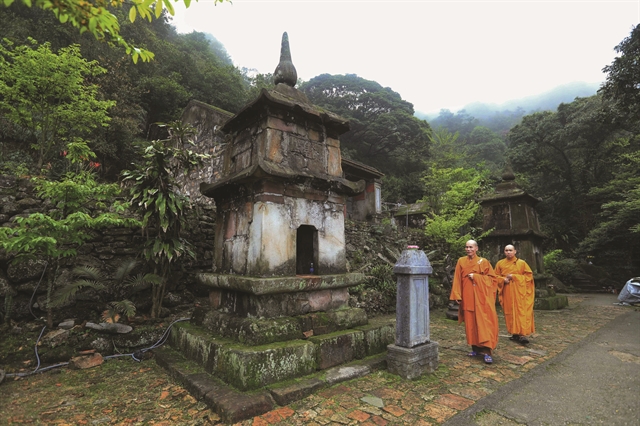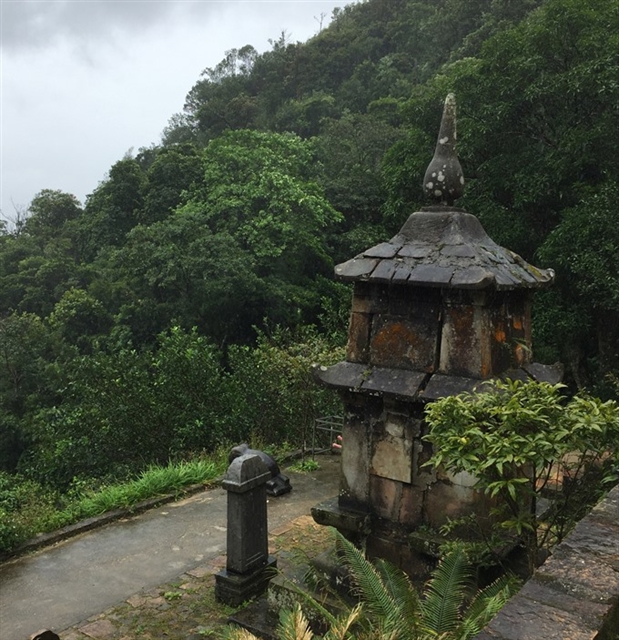By Bảo Ngọc
Ngọa Vân is a sacred pagoda located on Bảo Đài Mountain, in the territory of two communes, An Sinh and Bình Khê, in Quảng Ninh Province. Built during the Trần Dynasty (1225-1400), the pagoda was the final destination in King-Monk Trần Nhân Tông’s journey of Buddhist practice and enlightenment.
Trần Nhân Tông was the third king of the Trần Dynasty. He was born on November 11 (lunar calendar) in 1258, became the Crown Prince at 16 and ascended the throne at the age of 21.
After reigning for 14 years, in 1293 he ceded the throne to his son Trần Anh Tông, and retired to Thiên Trường Palace as Thái Thượng Hoàng (King's father) to guide and help the new king reign over the country.
Because of his admiration for the Zen monks of Yên Tử, in September 1299, when the young king was mature enough, Trần Nhân Tông officially got ordained as an ascetic at Tử Tiêu peak, Yên Tử Mountain.

Ngọa Vân is associated with King-Monk Trần Nhân Tông's journey of Buddhist practice and enlightenment. VNA/VNS Photo Thành Đạt
He founded Thiền phái Trúc Lâm Yên Tử (Trúc Lâm Zen Buddhism) -- a line of Buddhist meditation imbued with Vietnamese culture.
The King-Monk spent the rest of his life practising Buddhism, providing health services to the poor, and encouraging people to do good deeds. Finally, he chose Ngọa Vân Pagoda as the place to attain nirvana. Ngọa Vân has been considered the holy land of the Trần Dynasty and Trúc Lâm Zen Buddhism ever since.
Today Ngọa Vân is a pilgrimage site containing traces of ancient people in the Trần dynasty complex, and special national relic sites in Đông Triều.
From the foot of the mountain to the Ngọa Vân summit, researchers have found countless traces of ancient architecture and culture throughout different times, such as from the Trần, Lê and Nguyễn dynasties.

Ngọa Vân contains traces of ancient culture in the complex of the Trần Dynasty special national relic sites in Đông Triều Town. VNA/VNS Photo Thành Đạt
The most impressive examples are probably the architecture found in the Đá Chồng area, where archaeologists recently unearthed and discovered multiple layers of relics of the Lê Trung Hưng (Restored Lê) era from the foot to half-way up the hill.
The tower of Buddhist King-Monk Trần Nhân Tông on the top of Bảo Đài Mountain is a place containing many mysteries and is visited by pilgrims every year.

The tower of Buddhist King-Monk Trần Nhân Tông on the top of Bảo Đài Mountain contains many mysteries. VNS Photo Mai Hương
Ngọa Vân Pagoda means "Pagoda in the Clouds". At an altitude of 600 metres above sea level, the pagoda has beautiful landscape, leaning against the cloud-covered Ngọa Vân peak.
Surrounded by two mountain ranges on both sides and a beautiful valley in front, this sacred place is a perfect destination for those who want to find inner peace.
As a most sacred place, Ngọa Vân Pagoda has been developed as one of 14 tourism destinations in Quảng Ninh to meet the demand for spiritual tourism of monks and pilgrims across the country.

The statue of King-Monk Trần Nhân Tông in Ngọa Vân Pagoda on Bảo Đài Mountain. VNA/VNS Photo Thành Đạt
To create a chance for pilgrims and visitors to show respect and gratitude to Trần Nhân Tông, and to pray for a happy and peaceful year and to attract more tourists, the provincial authorities have worked hard to turn the location into an ideal destination for tourists.
A traditional path to the pagoda was paved and a cable car system was built to let visitors contemplate the peaceful atmosphere and the breathtaking beauty.
The pagoda relic complex includes four areas: Thông Đàn, Ngọa Vân, Đá Chồng and Ba Bậc, with 15 groups of different temples and towers.
Ngọa Vân Pagoda is the central part of the complex. In the past, people had to walk along a slippery, rocky path to get to the pagoda by starting from An Sinh Temple, going along Phủ Am Trà stream to Đô Kiệu slope and crossing Thông Đà.
A pilgrimage to Ngọa Vân Pagoda in winter has special meaning for Buddhists. Under the mist on the top of the mountain and the golden rays of the sun, visitors can feel the cold of winter, peace of mind, and an absolute purity when standing on the top of the mountain looking down.
The landscape here is also extremely airy. Those who have stayed at the temple in autumn during the moonlit nights find the scenery here like that of a fairyland.
Those who have knowledge of feng shui claim that the area has an extremely good location as there is "a blue dragon on the left and a white tiger on the right", mountains in front and behind, and water far away.
In order to preserve and promote the complex, in December 2020, on the 713th anniversary of King-Monk Trần Nhân Tông attaining nirvana, the People's Committee of Quảng Ninh approved a project to restore Ngọa Vân Am (Ngọa Vân Shrine) thanks to a donation from the Thiện Tâm Fund of Vingroup.
The project was carried out with the principle of preserving the antiquity of this Buddhist work. The construction was carried out under the strict supervision of archaeologists to ensure accuracy.
Ngọa Vân Pagoda was officially inaugurated on December 4, after the renovation.
It is now ready to welcome Buddhists and others to visit this holy land of Trúc Lâm Buddhism. VNS
OVietnam